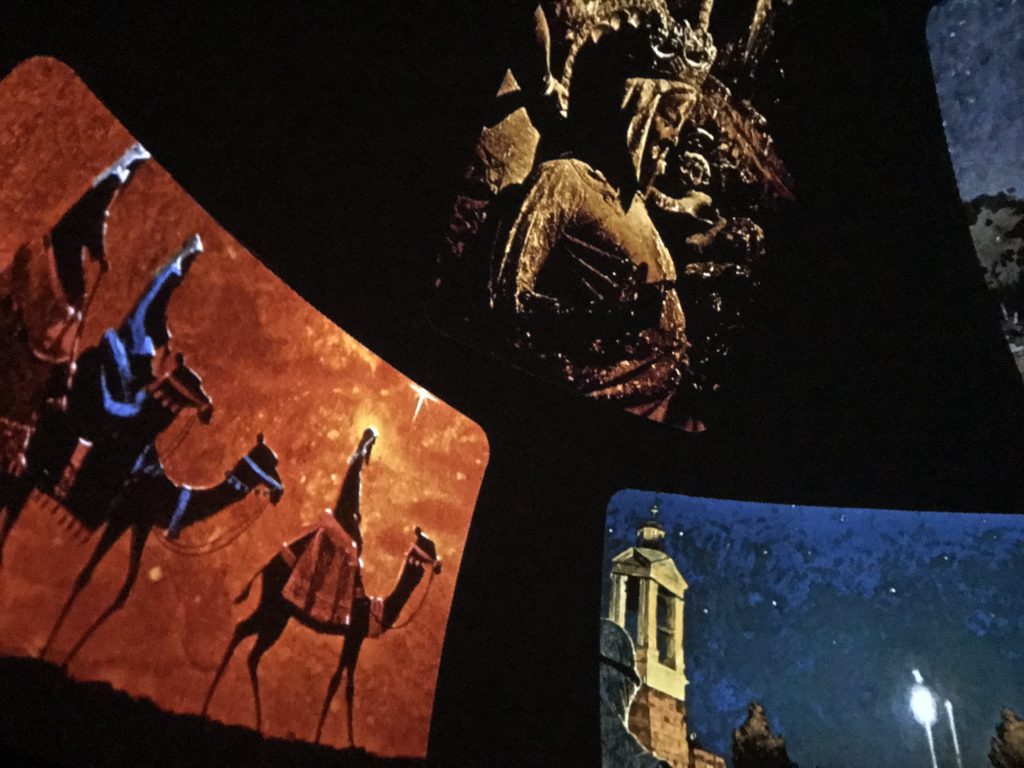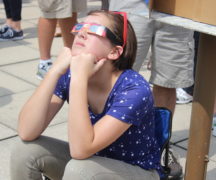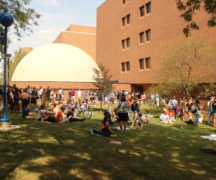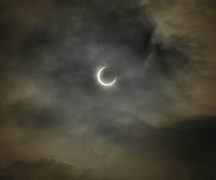By DAVID DUPONT
BG Independent News
Thirty years after “The Secret of the Star “ was first shown at the planetarium on campus, it still ends without a definitive answer.
Instead the show concludes with the sentiment that the year-end holiday season is a time of hope and light.
As to the nature of the star that in Matthew’s gospel led the Magi to the stable where Jesus was born, well that could be several things.
And Dale Smith, the planetarium’s director and creator of the show, is comfortable with all of them — it could be a legend, it could be the planets aligning, or it could be a miracle.

“The Secret of the Star” begins its 30th season tonight (Tuesday, Dec. 3) and continues through Dec. 15 with Tuesday and Friday shows at 8 p.m., Saturday shows at 2 p.m. and Sunday shows at 7:30 p.m. There’s a $1 suggested donation.
The program first made its appearance five years after the planetarium opened. Smith took his position with Bowling Green State University in 1983.
From the beginning, he said, the expectation was that there would be a Christmas or seasonal show, but the logistics of getting the planetarium up and running meant it was put off for a few years.
All planetariums do December shows of this kind. Some focus on the night sky solely, but that’s not the approach Smith wanted to take.
“People are curious what the star was so I wanted to approach that question in the context of the season,” he said. “With a Christmas show there’s an emotional component to people’s reaction that’s different from other shows,” Smith said. “It’s not a religious show. I was very careful of that.”
So he set together telling the story of the star using maps of the sky, narration, art, and music.
Those being the days at the dawn of the worldwide web, Smith had to put the show together using decidedly analog methods.
He went to the Sylvania branch of the Lucas County Public Library, coincidentally on Good Friday, and checked out all their books with Christmas imagery. After the first version of the narration recorded by Alex Hann was finished, Greg Predmore, “who had an amazing music library in his head,” put together the rough cut of the soundtrack on a cassette tape. The music evokes the season with only a hint of traditional carols. The show itself consisted of 500 slides in glass cases.
Five years ago the show was converted to digital, yet the message remains the same. “It holds up,” Smith said.
“The Secret of the Star” is divided into three parts.
The first looks at the history of how people in the Northern Hemisphere marked the coldest and darkest time of the year.
That was especially true in the far north where the sun barely shines, and the frozen landscape is believed to be inhabited by supernatural creatures. Many contemporary Christmas rituals grew from those celebrations. “Viking customs are our habits,” Smith said.
Pagan celebrations further south also had their influence. The Romans already celebrated Saturnalia to mark the passing of the winter solstice and the rebirth of the sun.
When church fathers looked for a day to celebrate the birth of Jesus, which is not clearly spelled out in the gospels, they adopted the Roman festival for their own celebration of “the birth of the Son.”
The second part tells the Nativity story using the words of the Bible. Smith said. Mostly the text is from the New Revised translation, but Smith does intersperse phrases from the New English translation because he feels they are more accurate.
The script, he said, is written in language akin to contemporary poetry, almost but not quite, metric. Among those who helped him with script writing was Lois Cheney, the creator of the Reader’s Theater on campus.
Smith reached out to her after he heard her speak at the First Presbyterian Church, where both were parishioners.
He asked her to view some of the first programs he created and “tell us everything we did wrong with the narration and how to correct it, and she did and she did.”
Cheney, who serves as one of the narrators on “The Secret of the Star,” said the speech was too fast, and also coached Smith on the principals of effective diction, such as not letting the volume drop at the end of the sentences and clearly articulating the last consonants in a word.
The final section of the program addresses the question implied in the theme: what was the star?
Well, if there was a star, it was probably planets.
Smith uses 7 BCE as the year of the Nativity, though, he said, a strong case can also be made for 4 BCE.
In 7 BCE there was a triple conjunction of Jupiter and Saturn with Mars making an appearance toward the end. This conjunction occurs every 800 years.
This celestial event would have lasted long enough for them to have traveled to Palestine from what is now Iran. “It took awhile. Camel wasn’t an express train. There were weeks and weeks involved.”
And, he added, “there’s a lot of emotional punch with the triple conjunction.”
That could also be true of a conjunction of Jupiter and the star Regulus that appears at the heart of the constellation Leo.
Other speculations of shooting stars or comets just don’t fit the story.
During the question and answer session at the end people will ask what he thinks the star is.
He doesn’t have a definitive answer for them. He finds people’s reactions interesting. Watching their body language he can see they are comfortable when he says it may have been a miracle. The reaction is similar when he says it could have been astronomical, and if it is, it involved a planetary conjunction. When he says it could be a legend, “people are not very comfortable.” That calls into question what else in the gospels may not be true.
But Smith says there’s no definitive proof for any of the three, and, as a Christian, he’s comfortable with them all.
Matthew, he noted, was a Jew writing for a Jewish audience, and they would have been familiar with a literary device where the writer uses a story that may not be factual to give meaning to an event.
“I didn’t want to say things in the show that I didn’t believe as a scientist I could support.”
He’s glad when he asks fellow Christians if he achieved the desired neutrality, but is more satisfied when an atheist or agnostic friend renders the same judgment.
Back when the show was new, a study found that regardless of what such a presentation said, people would come away believing it supported their preconceived notions.
***
For younger viewers, the planetarium is showing “The Alien Who Stole Christmas” on Saturdays (Dec. 7 and 14) at 3:30 p.m.





